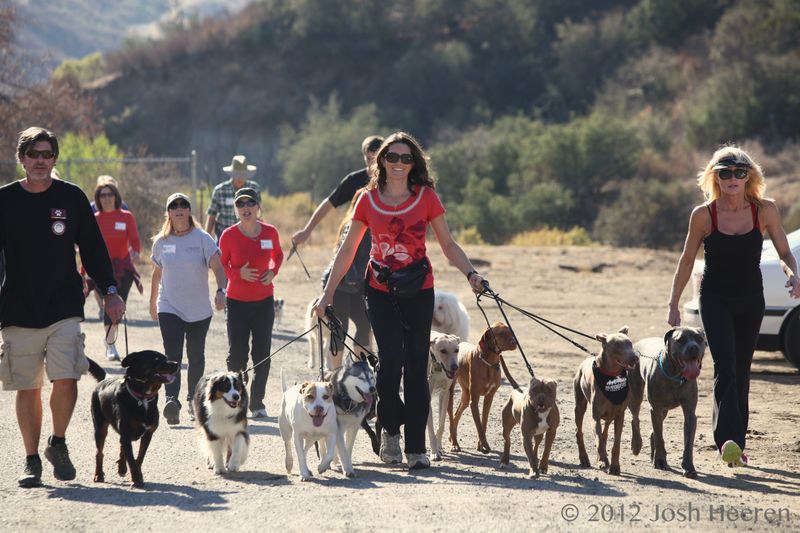
This summer, we conducted an unofficial (and involuntary) experiment: Take one unsocialized Rottweiler and see what five different dog trainers will do with it! When we first met three-year-old Molly at a local rescue group, she was wild and completely untrained, but she seemed sweet and longing to please. Apparently, this Rottie-mix had spent the first two years of her life just being chained up in a yard. The shelter volunteer called her a "junkyard dog." She didn't know what stairs were, a mirror, shopping carts. Every moving item sent her into a fit (bicyclists! Trash trucks!). A 10-minute walk with her was a full-body workout, with Molly darting in all directions. We had rehabilitated dogs before, but now we knew we needed professional help.
A rescue group recommended a resolute, but charming, trainer. Though she was expensive, after a thorough interview, her resumé with 30 years of experience, her promise to use "a holistic approach," "the most modern training techniques from around the world" and "positive reinforcement" convinced us. We pictured our dog running happily on her ranch with 20 acres, socializing with other dogs and getting rewarded after learning tricks. We would have loved to visit, but were told this wasn't possible.
Five weeks -- and almost $4,000 -- later, the trainer delivered Molly to our home. The first thing we noticed was how emaciated our dog was: her ribs were sticking out. Molly had lost more than 10 percent of her body weight. The trainer admitted that she didn't feed the dog when it didn't behave well. The trainer also showed us how to discipline our dog: When Molly pulled on the leash, we were to "karate chop" the pinch collar as hard as we could. "Harder, harder," the trainer would say. When Molly inched her paws off the stationing mat, the trainer very forcefully kneed her in the chest. When Molly got a little excited before the walk, the trainer jacked up the shock collar to send Molly wincing and jumping. Dog forgive us, we had made a terrible mistake!
Things only got worse. Molly seemed listless, and spent the first days just sleeping. We were in disbelief of how calm she was, her lack of stamina seemed unsettling. When we took her for walks, she started limping after less than half a mile. Her hesitation to perform a simple command such as "sit!" or "down!" seemed more due to pain than to defiance, all her slow, ginger body movements screamed pain. After a week, a vet confirmed our suspicion: Molly had severe inflammation in both shoulders. The x-rays showed fizzled bone splinters. While the trainer had chopped, kneed and jerked the seemingly stubborn dog, according to the vet our dog had been in "excruciating pain" all along.
We couldn't believe an experienced trainer would not have seen the many signs of illness Molly displayed: the frequent tremors, the listlessness, the limping. On top of it all, Molly's fears hadn't changed, on the contrary, some things had actually gotten worse since the training camp. She still panicked over everything loud, fast-moving or unfamiliar, especially other dogs. She lunged both at the vet and the surgeon. Later, we would learn that one cannot really train a dog unless the underlying issues of pain, fear and insecurity are addressed. Or maybe the pain caused her to lash out?
For the six-week rehabilitation period after a $5,000 surgery on both shoulders, our scooped up Rottweiler bounced off the walls in our apartment. We worked on her obedience and she became a perfectly well-behaved dog when no one else was around -- but as soon as a stranger or another dog approached, she still channeled Cujo. We discussed returning Molly to the shelter, but we knew it would be nearly impossible for such a physically and emotionally challenged dog to find a home. When she had recovered physically, we searched for a different trainer. The first one never responded to our written requests for an explanation, let alone an apology.
Our neighbors recommended Kirstin. Though she was only in her 20s, she already had an impressive resumé and three generations of animal training experience in her family tree. Her grandparents had trained elephants for the circus. Blonde and long-limbed, Kirstin was a Hollywood trainer to the stars. She entered our house under Molly's growling protest. She yelled at Molly to stop barking and growling -- most dog trainers will be careful not to do this: you can't correct a dog when you're already the "target," you need to build a relationship and some trust first. But Kristin asked us to put a muzzle on Molly, and then tried to "dominate" her by grabbing her "power points," the muzzle, the ruff, the paws. Our dog morphed into Voldemort and gave a Hollywood-worthy impersonation of the devil. Kirstin diagnosed "severe aggression," prescribed an herbal calmer for $200 (that proved to be useless) and prepared us for the worst: we might have to put the dog down. We broke into tears. The best thing Kirstin did was not to charge us for this piece of advice.
We are not ones to give up easily. Next, we went to a renowned training center at the other side of town. This, too, wasn't cheap at $150 per hour. Tempting us with waiving the consultation fee, they urged us to sign up for a package of private classes and laid out a detailed training plan for socializing our dog with stable dogs at their center. They would also come to our house where we frequently encounter off leash dogs. We signed. They literally waited until the moment after we had forked over our credit card for the entire package to reneg on the training plan: No, our dog couldn't be trusted to meet other dogs. No, they wouldn't visit our home. We spent three visits mostly parading around their empty parking lot, with the trainers asking us the same questions about feeding methods and toy aggression they had already asked us during the initial interview -- as if they didn't remember anything we had told them before. Very little training happened. They seemed to be more afraid of our dog than interested in helping her. We saw that this wasn't going anywhere and asked to cancel the contract. Surprise: The unused portion of the training sessions were nonrefundable under any circumstances. We should have read the small print.
After a short deviation with a fourth trainer who prescribed agility and attack training for dogs with aggression issues, but failed to show up for scheduled appointments, we felt we had heard it all: Every trainer had an entirely different approach, and the only thing they all agreed on was that the other trainers were wrong.
An unsocialized Rottweiler? Needed "a strong hand" (trainer 1) or "couldn't be rehabilitated" (trainer 2). Handfeeding? Was "essential" (trainer 1) or "dangerous" (3). Tug of war? Was "helpful" for aggressive cases to let off steam or "really dangerous and making matters worse." Collars? After the fourth trainer we had an extensive collection: tag collar, pinch collar, choke chain, Cesar Millan's Illusion collar, three different remote electronic collars, a slip leash, a halti and a gentle leader. I stopped counting after 10. And our dog was still having a nervous breakdown every time another pooch approached, even a chihuahua!
Cesar Millan, Michaela Haas, Junior and Molly at the Dog Psychology Center
We learned that our experience was not at all uncommon. I am writing about our journey because since then I have met many dog owners frantically reaching for "professional" help that is too often unprofessional. The title "professional dog trainer" is not protected in America. Anybody can call themselves a dog trainer, whether they are qualified or not. And as we saw firsthand, while most dog trainers know the basics of obedience training, very few are qualified to handle a scared Rottweiler. They tend to either use undue force or shy away from handling the dog at all. And they defend their various methods as religiously as any political party. When a dog trainer tells you that your dog cannot be rehabilitated, show them the door. Fast.
We had been avid watchers of the Dog Whisperer ever since we had rescued and rehabilitated a badly abused Akita-Chow mix three years ago. But getting Cesar Millan to come to our rescue seemed impossible -- maybe these days that's a privilege reserved for the very rich or famous. I finally reached two trainers who had worked with him and used his methods. Cheri Lucas, often featured on the Dog Whisperer show, and Brian Agnew happened to be in our area, and they came to our house.
When Molly barked and growled, Cheri and Brian didn't back off. They just stood their ground, calmly, neither shying away nor barging forward. They instantly diagnosed Molly as insecure, not aggressive. Cheri crawling into the playpen with our snarling Rottweiler would have been a neat opening for a Dog Whisperer episode. Call that confidence in your assessment! But this was even better: it didn't happen on TV, it happened in our home. After 10 minutes, they had Molly calmly walking on leash. After half an hour, their own dogs, a pit bull mix and a Collie were relaxing in our living room next to Molly. They showed me how to correct Molly when she freaked out: Gently, but firmly. Strongly, but calmly. They pointed out specific warning signals in her body language and the right moment for an acutely timed correction -- when she held her breath or tensed her jaw before the explosion. They used a halti, not a prong collar. When we sent Molly to Brian's home for more socialization, he sent us instagram proof of Molly's progress every day: Molly lying next to a pit bull puppy. Molly walking calmly with four other dogs at his side. We knew she was in good hands, and the progress she was making was amazing.
It wasn't the end of the project. Molly is still work in progress, but we become a better team every day. And recently, Molly even got a chance to go to the Dog Psychology Center and growl at Cesar to show her appreciation.
Cheri and Brian laughed knowingly when we told them about our odyssey. "We hear that all the time," they said, and joked: "The only thing five dog trainers can agree on is that they know more than their client." And I wouldn't even be sure of that.

Trainers Cheri Lucas and Brian Agnew with Michaela Haas and the pack
Photos: Josh Heeren

